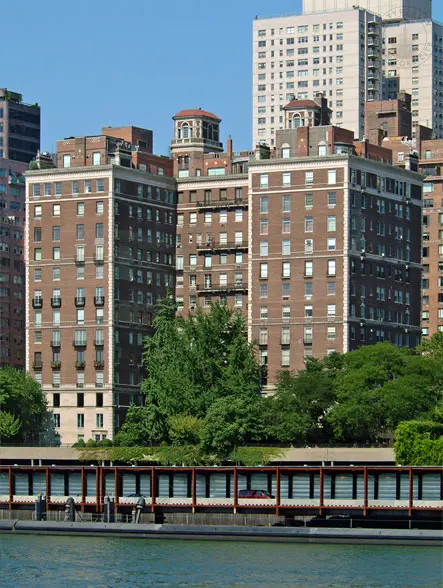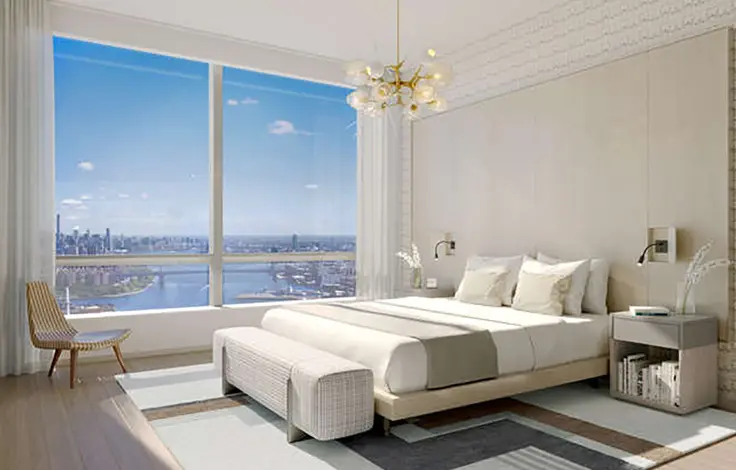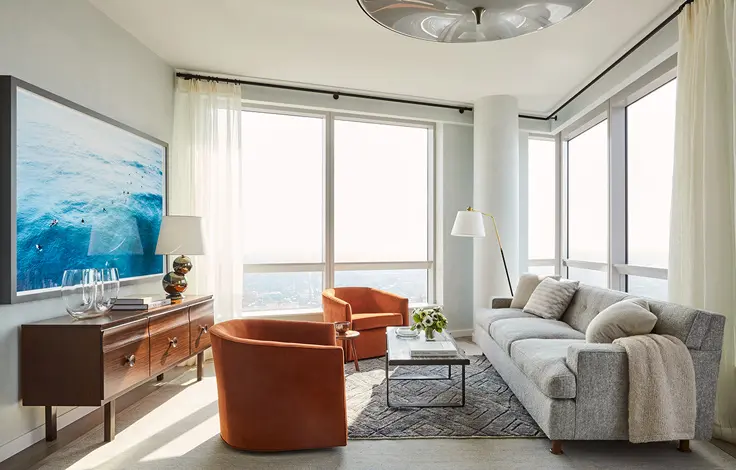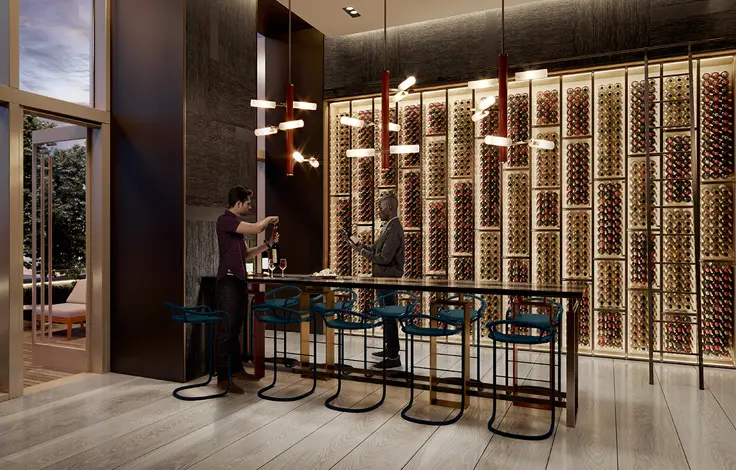1 Sutton Place South: Review and Ratings
View Full Building Profile


One of the city's grandest luxury apartment houses, One Sutton Place South is a freestanding structure overlooking the East River between 56th and 57th Streets.
The 14-story cooperative apartment house has an elegant triple-arched entrance driveway that opens to a lobby that, in turn, opens to its private garden facing the East River.
Passersby on the street can peer through the arches and glimpse the garden, providing a degree of transparency that is quite rare.
The handsome building, which has Italian Renaissance detailing, was completed in 1926 and was designed by Rosario Candela and Cross & Cross for the Phipps family.
It has 43 apartments.
Bottom Line
One Sutton Place South is the finest and most prestigious apartment building on Sutton Place and its only rival along the East River in terms of grandeur is River House, a few blocks to the south.
Description
From the East River, this is a U-shaped, red-brick building with a three-story limestone base and two small but very attractive “watertank” towers. The handsome building is distinguished by its triple-arched entrance on Sutton Place.
“The Devoted Classicist,” John J. Tackett, devoted an edition of his Internet blog to this building and remarked that the building’s “porte corchere entrance…allows autos to pull right up to the front door, eliminating the need to cross the sidewalk,” adding that “for many security-conscious residents, this is a valuable feature.”
Amenities
The building has a garden facing the East River, a doorman, a concierge and basement storage, but no roof deck, no garage and no health club.
Apartments
The building is topped by one of the city’s great penthouses, a 17-room unit that has 5,000 square feet of interior space and 6,000 square feet of terraces that wrap entirely around it. The apartment is notable for having two very large "drawing rooms" with curved bay windows at their north and south end of the building. The spectacular rooms had very tall ceilings, one of which contains a skylight.
The penthouse was created originally for Amy Phipps as a duplex. When her son, Winston Guest, the famous polo player and husband of C. Z. Guest, the garden columnist, took the apartment over, the lower floor was subdivided into three separate apartments, one of which is occupied by Bill Blass, the designer. The Guests lived on one side of the penthouse and one of their sons, Alexander, lived on the other side for several years and sold the apartment in 1963 about the time that their daughter, Cornelia Guest, was born.
The apartment was then acquired by Janet Annenberg Hooker, the philanthropist who died in late 1997 and was a sister of Walter Annenberg, the communications magnate and art collector. The legendary apartment was built on the market in early 1998 with an asking price of $15 million, the highest price for an apartment in the city.
Mrs. Hooker had lived formerly at 895 Park Avenue and had purchased a 60-inch dining table from French & Co., and ordered six 24-inch leaves for it. Robert Samuels Sr., the director of the famous antiques store asked why she got the leaves when she had no space. "One day I will," she was said, by her son, to have replied and indeed she used them all to create the 18-foot-long table in the penthouse's 28-foot dining room.
The apartments have fireplaces and high ceilings.
Apartment 11B is a two-bedroom unit that has a 16-foot-long entry foyer that leads to a 22-foot-long living room with a wood-burning fireplace and a 18-foot-long dining room next to a 14-foot-long kitchen.
Apartment 3B has a 27-foot-long entrance gallery that leads to a 31-foot-long living room and a 19-foot-long dining room next to a 14-foot-wide kitchen. The apartment has two bedrooms and a 14-foot-long servant’s room.
Apartment 5D is a two-bedroom unit that has an 11-foot-long entry foyer that opens into a 13-foot-wide library adjacent to a 34-foot-long living room with a wood-burning fireplace that leads to a 13-foot-square dining room and a small enclosed kitchen.
Apartment 7A is a four-bedroom unit that has a 34-foot-long entrance gallery that leads to a 30-foot-long living room with a wood-burning fireplace, a 24-foot-long library with a wood-burning fireplace, and a 26-foot-long dining room off a butler’s pantry and a 20-foot-long enclosed kitchen with a 12-foot-wide pantry. The apartment has a 14-foot-long study, a laundry, two staff rooms and a 21-foot-long servant’s dining room. The master bedroom has a wood-burning fireplace.
History
Candela is widely considered to have been the country's greatest designer of luxury apartment buildings and he collaborated with many of the city's most famous architectural firms.
Born in Sicily, Candela came to the United States in 1909 and graduated from the Columbia School of Architecture in 1915. His other famous buildings include 834 and 960 Fifth Avenue, 720, 740, 775 and 778 Park Avenue, and 19 East 72nd Street, all considered among the most glamorous addresses in the city.
Cross & Cross is best known for its design of the former RCA Victor tower on Lexington Avenue at 51st Street overlooking St. Bartholomew's Episcopal Church on Park Avenue. Candela also collaborated with Cross & Cross on the design of 720 Park Avenue.
Candela's buildings, "it is said, were the grandest of the decade that was itself the greatest," wrote Elizabeth Hawes in her book, "New York, New York, How The Apartment House Transformed The Life Of The City (1869-1930)," published by Henry Holt in 1993.
"He had a respect for privacy and an eye for significant detail. He was a complete thinker. He added duplicate water connections to street mains and multiple switches for ceiling lights as well as beautifully turned staircases and separate wine cellars. More significantly, he designed buildings from the inside out. He placed windows where they received light, balanced a room, or allowed a graceful arrangement of furniture....
Candela also invested unusual energy in the entry hall. In a typical apartment, he made it a full-sized room with rich views into the interior because he thought it was important to greet a visitor with a full sense of a home... Candela liked puzzles. During the Depression, he took up cryptography, and during World War II, he broke the Japanese code," Hawes wrote.






 6sqft delivers the latest on real estate, architecture, and design, straight from New York City.
6sqft delivers the latest on real estate, architecture, and design, straight from New York City.
